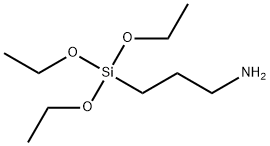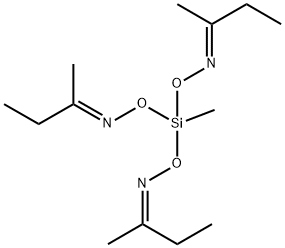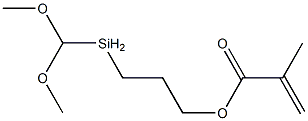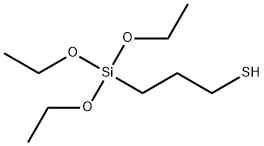1-[3-(Trimethoxysilyl)propyl]urea
Synonym(s):γ-Ureidopropyltrimethoxysilane;N -[3-(Trimethoxysilyl)propyl]urea;3-Ureidopropyltrimethoxysilane;Ureidopropyltrimethoxysilane
- CAS NO.:23843-64-3
- Empirical Formula: C7H18N2O4Si
- Molecular Weight: 222.31
- MDL number: MFCD00216654
- EINECS: 245-904-8
- SAFETY DATA SHEET (SDS)
- Update Date: 2024-01-22 14:59:33
![1-[3-(Trimethoxysilyl)propyl]urea Structural](https://img.chemicalbook.in/CAS/GIF/23843-64-3.gif)
What is 1-[3-(Trimethoxysilyl)propyl]urea?
Chemical properties
Amber clear liquid
The Uses of 1-[3-(Trimethoxysilyl)propyl]urea
1-[3-(Trimethoxysilyl)propyl]urea capped magnetic nanoparticles can be used as catalyst supports for immobilizing the surface enzymes and nanoparticles. It may be used in the silanization of ceria that finds potential applications as medical agents.
General Description
1-[3-(Trimethoxysilyl)propyl]urea is a urea based surface modifying agent that is used for forming self-assembled monolayers (SAMs) on a variety of substrates. It is mainly utilized to immobilize the surface atoms by forming a ligand.
Properties of 1-[3-(Trimethoxysilyl)propyl]urea
| Melting point: | <-25°C |
| Boiling point: | 217-250 °C(lit.) |
| Density | 1.15 g/mL at 25 °C(lit.) |
| vapor pressure | 1 mm Hg ( 20 °C) |
| refractive index | n |
| Flash point: | 210 °F |
| storage temp. | under inert gas (nitrogen or Argon) at 2-8°C |
| form | liquid |
| pka | 14.27±0.46(Predicted) |
| Specific Gravity | 1.15 |
| color | Colorless to Light yellow |
| Water Solubility | 240-1000g/L at 20℃ |
| Hydrolytic Sensitivity | 7: reacts slowly with moisture/water |
| CAS DataBase Reference | 23843-64-3(CAS DataBase Reference) |
| EPA Substance Registry System | [3-(Trimethoxysilyl)propyl]urea (23843-64-3) |
Safety information for 1-[3-(Trimethoxysilyl)propyl]urea
| Signal word | Danger |
| Pictogram(s) |
 Corrosion Corrosives GHS05  Exclamation Mark Irritant GHS07 |
| GHS Hazard Statements |
H315:Skin corrosion/irritation H318:Serious eye damage/eye irritation H335:Specific target organ toxicity, single exposure;Respiratory tract irritation |
| Precautionary Statement Codes |
P261:Avoid breathing dust/fume/gas/mist/vapours/spray. P280:Wear protective gloves/protective clothing/eye protection/face protection. P305+P351+P338:IF IN EYES: Rinse cautiously with water for several minutes. Remove contact lenses, if present and easy to do. Continuerinsing. |
Computed Descriptors for 1-[3-(Trimethoxysilyl)propyl]urea
New Products
4-AMINO-TETRAHYDRO-PYRAN-4-CARBOXYLIC ACID HCL 4-(Dimethylamino)tetrahydro-2H-pyran-4-carbonitrile 4-Aminotetrahydropyran-4-carbonitrile Hydrochloride (R)-3-Aminobutanenitrile Hydrochloride 3-((Dimethylamino)methyl)-5-methylhexan-2-one oxalate 1,4-Dioxa-8-azaspiro[4.5]decane 5-Bromo-2-nitropyridine Nimesulide BP Aceclofenac IP/BP/EP Diclofenac Sodium IP/BP/EP/USP Mefenamic Acid IP/BP/EP/USP Ornidazole IP Diclofenac Potassium THOMAIND PAPER PH 2.0 TO 4.5 1 BOX BUFFER CAPSULE PH 9.2 - 10 CAP SODIUM CHLORIDE 0.1N CVS ALLOXAN MONOHYDRATE 98% PLATINUM 0.5% ON 3 MM ALUMINA PELLETS (TYPE 73) LITHIUM AAS SOLUTION 2-Bromo-1-(bromomethyl)-3-chloro-5-nitrobenzene 2-Bromo-3-nitroaniline N-(3-Hydroxypropyl)-N-methylacetamide 3-Bromo-6-chloropyridazine 4-ethyl-3-nitrobenzoic acidRelated products of tetrahydrofuran








You may like
-
![1-[3-(Trimethoxysilyl)propyl]urea CAS 23843-64-3](https://img.chemicalbook.in//Content/image/CP5.jpg) 1-[3-(Trimethoxysilyl)propyl]urea CAS 23843-64-3View Details
1-[3-(Trimethoxysilyl)propyl]urea CAS 23843-64-3View Details
23843-64-3 -
![1-[3-(Trimethoxysilyl)propyl]urea CAS 23843-64-3](https://img.chemicalbook.in//Content/image/CP5.jpg) 1-[3-(Trimethoxysilyl)propyl]urea CAS 23843-64-3View Details
1-[3-(Trimethoxysilyl)propyl]urea CAS 23843-64-3View Details
23843-64-3 -
 1823368-42-8 98%View Details
1823368-42-8 98%View Details
1823368-42-8 -
 2-(3-(tert-butyl)phenoxy)-2-methylpropanoic acid 1307449-08-6 98%View Details
2-(3-(tert-butyl)phenoxy)-2-methylpropanoic acid 1307449-08-6 98%View Details
1307449-08-6 -
 Ethyl 3-(furan-2-yl)-3-hydroxypropanoate 25408-95-1 98%View Details
Ethyl 3-(furan-2-yl)-3-hydroxypropanoate 25408-95-1 98%View Details
25408-95-1 -
 2-Chloro-5-fluoro-1-methoxy-3-methylbenzene 98%View Details
2-Chloro-5-fluoro-1-methoxy-3-methylbenzene 98%View Details
1805639-70-6 -
 1784294-80-9 98%View Details
1784294-80-9 98%View Details
1784294-80-9 -
 Lithium ClavulanateView Details
Lithium ClavulanateView Details
61177-44-4
Statement: All products displayed on this website are only used for non medical purposes such as industrial applications or scientific research, and cannot be used for clinical diagnosis or treatment of humans or animals. They are not medicinal or edible.